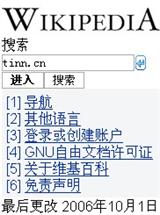Create a portable private Wiki system with TiddlyWiki
At first glance, TiddlyWiki appears to be a static webpage with an ordinary WEB 2.0 style! But actually, you're mistaken! Move your mouse and click on one of the links on the page – you'll be amazed. It's far more than just a simple webpage!
That's right! What you've seen so far is just the surface-level dynamic display effect of TiddlyWiki! It's dazzling and full of motion! If you think that all it has to offer is this visually striking appearance, then let me clearly tell you: you're wrong again!
You haven't yet explored its functionality, which goes much deeper than mere visual effects.
This webpage isn't just something static for viewers to look at; in fact, you can also "personally participate in changing its appearance!"
Interactive, dynamic webpages are common these days, so there’s no reason to be overly surprised. However, the webpage before us called TiddlyWiki doesn’t primarily aim to enable online interaction with others. Instead, it provides you with a simple, easy-to-use, and extremely powerful digital notebook system!
Let me list some of TiddlyWiki's features below:
**Tag-based organization.** Things inherently need to be categorized and managed, but TiddlyWiki doesn't use a tree-based hierarchical system (which might remind you of biological phylogenetic trees...). Instead, it uses the popular "tag" management system. Each item can belong to multiple categories, and tags aren't restricted to hierarchical relationships of superior or subordinate. Instead, they can have mutual dependencies while maintaining equal status, functioning more like "sets."
Some tagged notes may not even have their own content—they may "not exist" as standalone entries—but they still list sub-entries, i.e., notes labeled with that tag. This creates a closer relationship between notes!
Moreover, since tags are attached to notes, we can naturally find the associated tags at the top of each note, and those tags themselves are clickable entries.
Adding tags to notes is incredibly easy. While editing any note, simply follow the instructions mentioned below: you can input a new category term or the name of an existing entry to make the current note a sub-entry under it. You can also set up reciprocal tagging...
---
以上是翻译的内容,希望对你有帮助!




